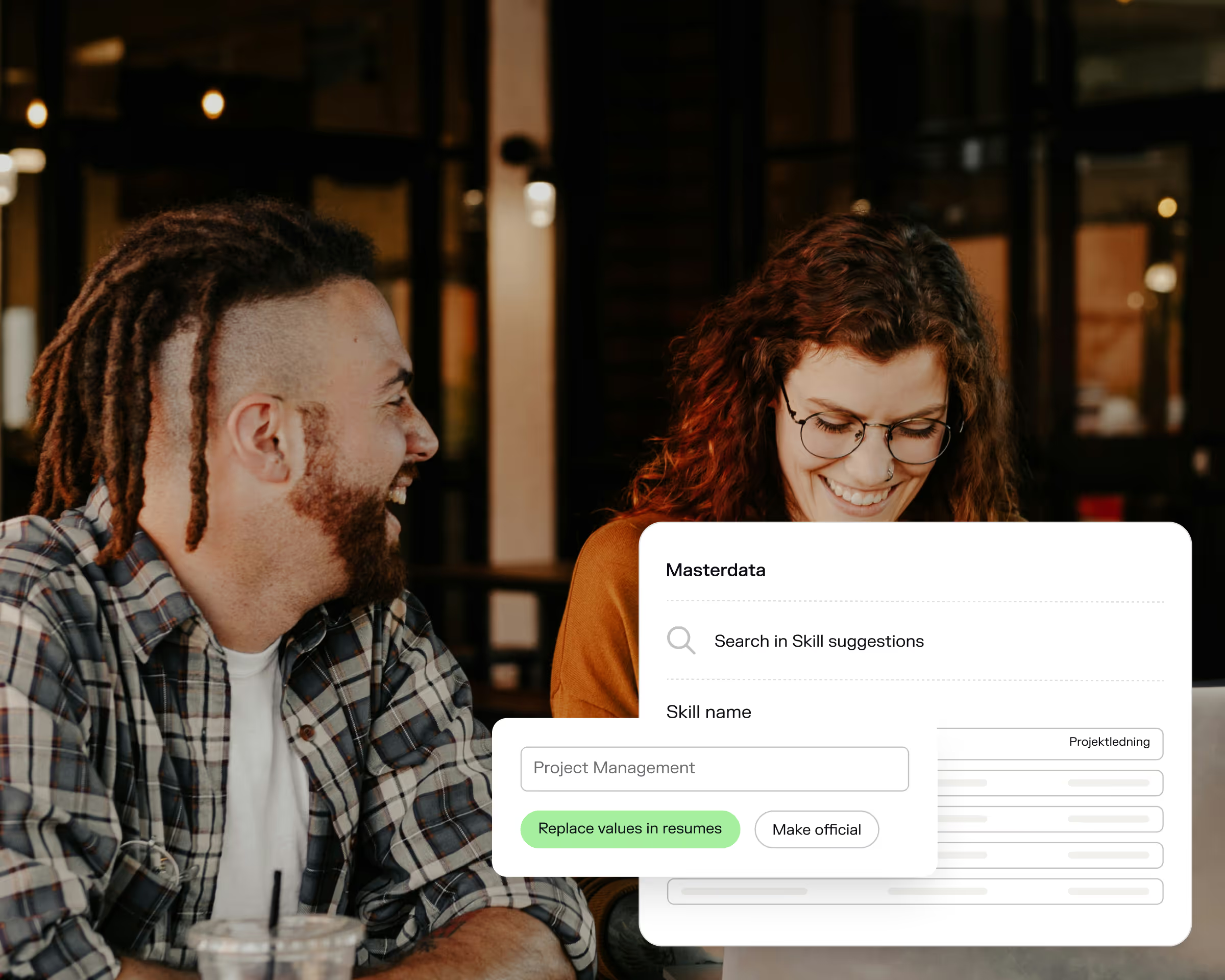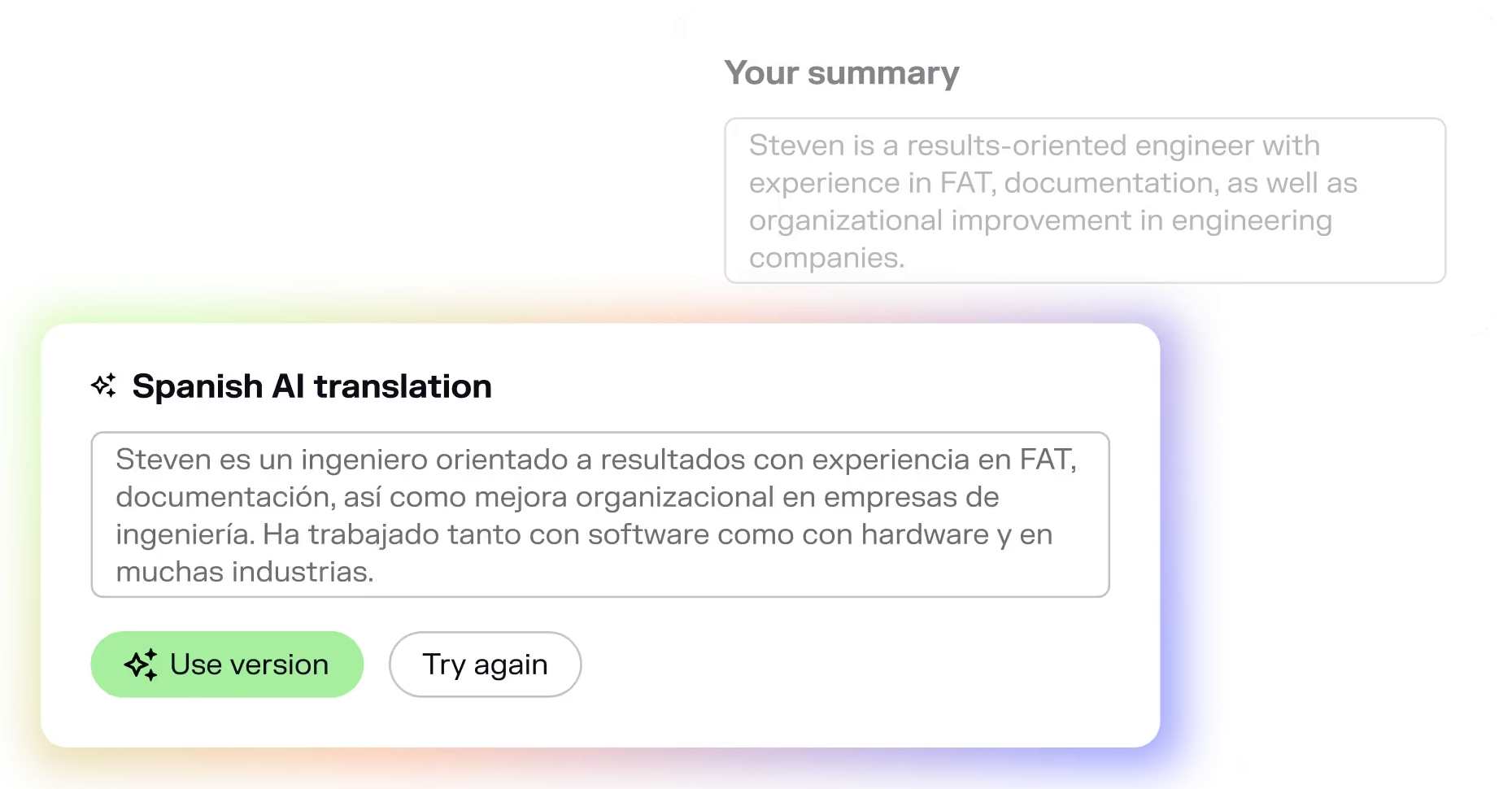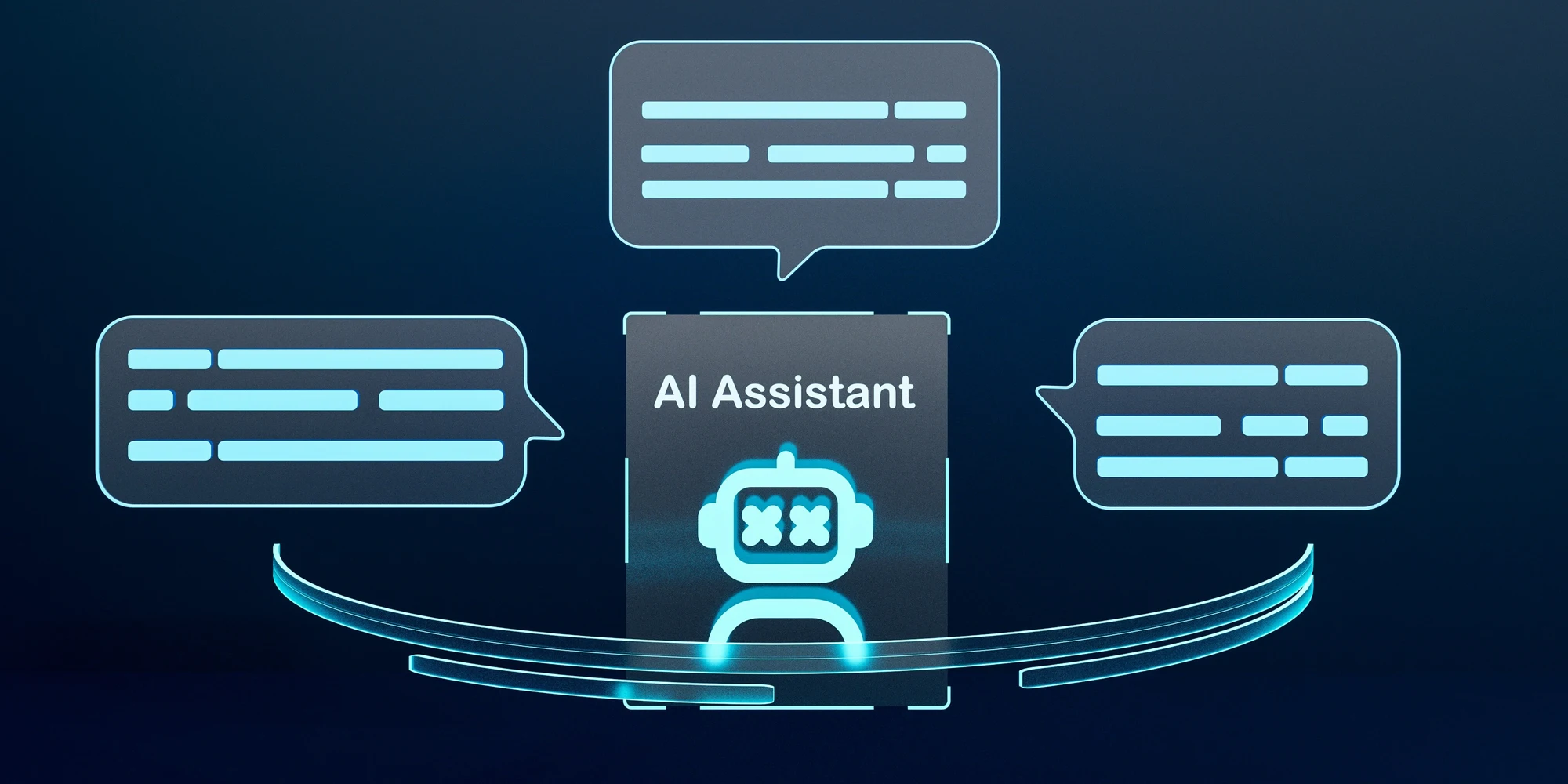AI has become one of the most talked-about topics in business — and proposal management is no exception. From AI-generated content to automation tools that promise to build proposals in minutes, the landscape is changing fast. But with all the noise, it’s hard to know what’s actually useful, and what’s just hype.
The truth is, AI can significantly improve the proposal process. It can save time, reduce repetitive work, and even improve quality. But only if it’s applied in the right way, on top of the right foundation. Most importantly, AI should support your team, not replace it.
In this guide, we walk through the real-world applications of AI and automation across the proposal lifecycle — from data preparation and team selection to writing, tailoring, formatting, and translations. We also explore how to implement AI responsibly, how to stay compliant with emerging regulations, and how Flowcase is helping professional services firms build smarter, faster, and more tailored proposals.
Whether you’re just getting started or looking to improve the tools you already use, this is your practical, no-fluff guide to proposal AI.
Quality Data Underpins Everything in AI
Before we dive into the guide, it’s important to highlight one key thing: AI can’t function without reliable input. No matter how advanced the tool or how impressive the features, the quality of its output depends entirely on the quality of the data feeding into it. In proposal management, that means structured, consistent, and up-to-date information — about your people, your projects, your templates, and your previous bids.
This is true across the board. If you want AI to help you draft proposal content, it needs accurate background information. If you want it to assemble teams, it needs a clear picture of who has which skills and where they’ve worked. If you want to automate formatting, it needs standardized inputs. When that data is messy, fragmented, or buried in PDFs and spreadsheets, AI won’t save you time — it will create more work.
Among the most difficult, and most important — areas to get right are resumes and case studies. These are often owned by different people, scattered across systems, and rarely updated in a structured format. And yet, they’re central to most bids. Without clean data here, you can’t confidently reuse past content, tailor submissions, or apply AI to improve efficiency.
We explore this in more depth in our blog, Why Good Data is the Foundation for AI-Powered Bids and Proposals. If you want your AI investments to pay off, this is where it all begins.
Next we’re going to cover some actionable steps for where AI can improve your proposal process, and where Flowcase can help:
Step 1: Centralizing & Leveraging Proposal Data
Now that you’re aware of how important strong data is, the next critical step is centralizing it. No matter how good your data is, if it’s spread across disconnected folders, teams, and systems it still poses a major barrier to automation. In this section we’ll discuss how you can overcome this.
To work reliably, AI needs access to the full picture. If some resumes are buried in Word docs, project details live in a spreadsheet, and skills are stored in someone’s head, no tool, no matter how advanced, can deliver accurate results. That’s why creating a central source of truth is essential. It ensures your proposal content is consistent, complete, and available exactly when you need it.
Centralization makes everything work better. It enables accurate skills search, faster profile tailoring, smoother document generation, and more confident team selection. It also reduces duplication of effort, cuts down on inconsistencies, and allows multiple teams, from Bid teams to HR to Marketing, to work from the same foundation.
But here’s the challenge: centralizing all this data manually can be a huge task. That’s why at Flowcase, we’ve built AI tools to help accelerate the process of centralization itself.
Here’s how we help:
- AI Data Import feature allows team members to bring in information directly from resumes, LinkedIn profiles, and past project case studies — automatically extracting and structuring the content into a searchable format.
- AI Skill Suggestions help enrich and standardize profiles by identifying missing capabilities or inconsistently phrased skills.
- Years of Experience automation updates your skills and roles automatically based on the time scales in your resume.
- People are connected to the projects they’ve worked on, meaning data flows between the two, ensuring consistency across all project workers.

With all of this information centralized in Flowcase, your people and projects can then be searched across.
Our smart search engine allows proposal professionals to quickly find the right people and past projects based on precise filters — such as expertise, certifications, regions, client types, and more. And when you’re not sure who fits best, our AI Similar Profiles feature helps surface candidates who are alike - perfect when your first choice is unavailable.
Unified, intelligent data is the key to scalable, AI-enabled proposal work. Learn more about these features and even try them out in our interactive demo using the link below.
Step 2: AI Writing: How to Use Generative AI Wisely
AI writing doesn’t belong to just one part of the proposal process. You might encounter AI writing tools while preparing foundational content like case studies or team resumes. You might also use them when tailoring a final submission for a specific bid. In reality, AI writing can support your workflow at almost any stage — but we’ve chosen it as our second step since centralizing proposal data is so important.
Used well, AI can help you write faster, improve clarity, and maintain consistency across documents. However, used blindly, it can ‘hallucinate’ and provide content that’s inaccurate and damaging. Therefore, it’s not a shortcut for critical thinking — and it’s certainly not a replacement for human judgment, especially when responding to complex or technical RFPs.
The Role of Generative AI in Proposals
The rise of generative AI has opened the door to faster, more efficient content creation. You can now ask a tool to rephrase a resume summary, summarize a long project description, or adjust the tone of a paragraph for a client-facing proposal — and get a decent first draft in seconds.
But just because AI can write something, doesn’t mean it should. When the stakes are high, generative AI tends to fall short, like responding to evaluation criteria, describing a unique methodology, or demonstrating deep client insight. It lacks the context, nuance, and industry expertise required to hit the mark. Even worse, it may confidently insert incorrect or misleading details if the underlying data is vague or inconsistent.
That’s why the most effective use of AI writing tools isn’t to take over the writing, it’s to support the writer.
Where AI Writing Works Best
AI shines when used for:
- Drafting initial templates or placeholders for future editing
- Adjusting tone and voice for different audiences
- Proofreading bios and descriptions for grammar and flow
- Reducing text across resumes and case studies to meet word count limits
It’s especially helpful in fast-moving proposal environments where you need to ensure content is clear, consistent, and aligned to a client’s expectations — without writing from scratch every time.
For a deeper look at how generative AI fits into proposal writing and how Flowcase can help, check out our blog:
AI Proposal Writing: When to Utilize Generative AI for Bids & Proposals and When to Avoid It →
Why In-Context AI Tools Matter
It’s also worth mentioning that it’s not just what AI does — it’s where and how it does it. Context-aware tools, like the ones embedded within Flowcase, allow teams to apply AI to specific fields within their actual workflow: shortening a project summary within a resume, rewriting a personal bio directly in the editor, or applying AI to individual sections of a case study. This keeps everything grounded in accurate, structured content — not generic prompts or standalone apps.
When AI is applied within context, based on well-organized data, the results are faster, more usable, and more accurate. It’s the difference between generating content that works — and generating content that creates more work.
There are a range of other reasons why in-app AI is much more powerful than standalone tools. We discuss these in more detail in the blog below:
Step 3: Supporting Global Bids with AI-Powered Translation (Optional)
Not every proposal team operates across borders, but for those that do, language becomes a major obstacle. Responding to international RFPs means more than simply submitting content in another language. It requires ensuring that the tone, formatting, and technical accuracy of your proposal remain intact — even when translated at scale.
And that’s easier said than done.
The Challenge of Multilingual Proposal Content
Proposal teams are often tasked with translating dozens — sometimes hundreds — of documents: resumes, case studies, methodology descriptions, and more. But these aren’t static brochures. They’re tailored, context-sensitive materials that need to sound natural, professional, and consistent in another language.
Manual translation is time-consuming, expensive, and hard to maintain. Yet traditional AI translation tools (like copy-paste workflows through Google Translate) lack formatting control and often distort meaning, especially in specialized or technical industries. They might misinterpret project roles, skip over nuance, or lose key qualifiers that evaluators care about.
What you need is scalable, accurate, and context-aware translation — and that’s where embedded AI tools can make a meaningful difference.
How Flowcase Handles Translation at Scale
Flowcase allows you to translate resumes and case studies directly within the platform — with just a few clicks. These AI-powered translations preserve the original formatting and structure of your templates, so translated resumes don’t break your proposal layout.
Because Flowcase uses structured data behind the scenes, the translation engine can recognize sections (like job titles, skills, project outcomes) and maintain the correct context for each. The result is more accurate, industry-appropriate translations that feel human — not mechanical.
This means teams can confidently submit bids in French, Spanish, German, or any other supported language — without spending weeks manually recreating content.

If you work across borders (or plan to in the future) AI translation isn’t just a nice-to-have. It’s an essential tool to expand your reach without stretching your resources.
Related reading:
How AI Can Translate Resumes and CVs to Make Global Bidding a Breeze →
Step 4: AI Tailoring - Making Every Proposal Feel Made for the Client
Tailoring is one of the most important parts of proposal writing. It’s where you move beyond generic content and show the client that you understand their specific needs, challenges, and expectations. A strong track record alone is only half the battle; a relevant, well-positioned story is the rest.
But tailoring every resume, case study, and section of the proposal takes time — and teams often cut corners simply to meet deadlines. This is where AI and automation can help.
With Flowcase you can easily reorder resume and project content, highlight specific achievements, and choose from pre-tailored sections in a drag-and-drop builder.
As touched on earlier, our platform also includes built-in AI tools like text reduction to help teams meet formatting requirements without sacrificing clarity or meaning. Meanwhile, AI proofreading also helps to polish content when necessary.
And we’re going further. We’re actively developing new AI-powered Tailoring tools designed to go even deeper — allowing users to match proposal requirements with your most relevant people and projects, and even auto-tailor their content accordingly. Keep tuned for updates, but in the meantime, we talk more about AI Tailoring in this blog.
Step 5: Automating Proposal Formatting
Formatting should be the easy part. But in most proposal teams, it’s a massive time drain.
Manually copying and pasting content into either branded layouts, or bid-specified templates is a tiresome, time-intensive endeavour. On top of this, it often happens at the very end of the process, under deadline pressure, when there’s no room for error.
And yet, formatting is one of the easiest things to automate — if your content is structured properly.
When proposal content follows a consistent structure, and your templates are mapped to that structure, formatting becomes a click-and-go process. This isn’t just about saving time (though it will). It also ensures consistency across deliverables, reduces human error, and makes last-minute edits far less risky.

Flowcase enables teams to specifically export their resumes and case studies into branded or bid-mandated templates in just a few clicks. This is a key document to automate, since in many bids you’re putting forward multiple (sometimes dozens) of team members. And when strict layouts need to be followed, this continuous copying and pasting can become a huge time-drain. Whether it’s the SF 330, the Europass, the World Bank template, the GSA MAS or many other mandated layouts, or perhaps it’s your own custom branded templates, we’ve got you covered.
Sure, this isn’t strictly AI, but it’s automation at its finest. It takes a long, error-prone job and simplifies it in seconds.
Related reading:
How to Format a Proposal in Seconds with RFP Automation Tools →
Step 6: Building Trust in an AI World
When AI can generate content at the click of a button, credibility becomes more important than ever. Clients know AI is being used — and while that’s not inherently a bad thing, it does raise a natural question: Who’s really behind this proposal?
That’s why building and maintaining trust is just as important a topic as the AI tools themselves.
To gain this trust, proposals need to go beyond professionally written text. They need to emphasize the real people behind the work, demonstrate genuine industry experience, and show that you understand the client’s world — not just their requirements. Personalization, specificity, and relationship-building matter more than ever in a time when generic content is easy to produce.
Human connection is essential. This means showcasing your team with headshots and customized bios, highlighting testimonials from past customers, and bringing a degree of personality and partnership into the process. Trust comes from demonstrating that you’re not just capable of doing the work — but that you’re the kind of team they want to work with.
We explore this in more detail in our blog:
5 Steps to Building Client Trust in the Age of AI →
While we’ve now covered the actionable steps you can take to use AI effectively in your organization, it’s just as important to understand the broader landscape — including emerging regulations and what to consider when choosing AI vendors.
Navigating AI Regulations: Stay Ahead, Stay Compliant
As AI tools become more powerful, they’re also coming under greater scrutiny. Regulatory frameworks like the EU AI Act are setting new standards around transparency, accountability, and risk — particularly in how AI systems interact with users and process personal data.
For proposal teams, this isn’t just a legal issue — it’s a strategic one. You’re often handling sensitive, client-facing information. Any tool that uses AI to generate or manipulate proposal content must do so in a way that’s both compliant and trustworthy.
Much like GDPR forced companies to rethink how they store and use personal data, the EU AI Act is pushing firms to take a more responsible approach to automation and machine learning. Even if your organization isn’t based in the EU, this regulation will likely shape global standards.
That’s why it’s essential to work with vendors who prioritize AI compliance — and to stay informed about how your tools collect, process, and use data.
Related reading:
Navigating the Future of AI Regulation: Lessons from the EU’s GDPR for Global Companies →
Flowcase’s Approach to AI: Responsible, Practical, and Evolving
When adopting AI tools, it’s not just about what the software can do — it’s about how it does it. Working with vendors who have a responsible, transparent, and purpose-driven approach to AI is essential to ensure compliance, protect your data, and avoid falling for “AI for AI’s sake.”
At Flowcase, we ground our approach to AI in three core values: data privacy, real-world usefulness, and continuous learning.
1. Data privacy comes first.
We never use customer data to train our AI models, and we never share data between customers — ever. All AI features are strictly opt-in, ensuring full control and consent at every step.
2. Real-world application over hype.
We don’t build AI features for the sake of marketing. Everything we release is designed to solve real problems our users face — whether that’s writing more efficiently, reducing word count, translating resumes, or identifying the right project for a proposal.
3. A mindset of continuous learning.
We stay informed about the latest developments in AI — and we don’t just chase trends. We evaluate risks, anticipate regulatory changes, and keep refining our tools to deliver meaningful, trustworthy results.
This balanced approach allows us to deliver powerful, responsible AI features that actually help teams win more work — without compromising trust.

Related reading - the people that power our AI innovations:
The Face Behind the Tech: Simen's Work with AI Translations →
The Face Behind the Tech: Christoffer's Work with AI →
Conclusion: The Future of Proposal Management Is Human + AI
AI isn’t here to replace proposal professionals — it’s here to empower them. When built on structured, centralized data and used with the right intent, AI can dramatically improve the speed, quality, and impact of your proposals. From writing and tailoring to team selection, formatting, and translation, the firms that learn to use AI wisely will have a lasting competitive edge.
But the tools alone aren’t enough. Responsible implementation, trustworthy data practices, and a commitment to human-centered storytelling will define the next generation of winning proposals.
Ready to streamline your proposal process with the power of AI? Schedule a demo with Flowcase today.
FAQ: AI and Automation in Proposal Management
What is AI in proposal management?
AI in proposal management refers to using artificial intelligence tools to automate, enhance, or streamline tasks within the proposal creation process. This includes writing assistance, resume matching, data extraction, formatting automation, translation, and more.
Can AI write proposals?
Yes — to a degree. AI can help write or rewrite sections of a proposal, especially repetitive content like resumes, case studies, or executive summaries. However, human review is essential to ensure accuracy, tone, and client alignment. AI works best as a support tool, not a full replacement.
How does AI help with tailoring proposals?
AI can analyze RFP requirements and help match the right resumes, case studies, and project examples to each opportunity. It can also rewrite or summarize content to align better with the client's language or expectations, saving time during customization.
Is it safe to use AI in proposals?
It can be — as long as you're working with vendors who prioritize data privacy and regulatory compliance. Look for platforms that don’t train their models on your data, allow opt-in controls, and follow emerging regulations like the EU AI Act.
Can AI help with resume and case study management?
Absolutely. AI can extract key information from resumes and project summaries, suggest missing skills, translate content, and reduce word count. When paired with a centralized system, it becomes much easier to maintain, search, and tailor this content.
How do I get started with AI for proposals?
Start by cleaning and structuring your existing content — especially resumes and case studies. From there, look for tools that integrate AI into your daily workflow (not just standalone apps), and focus on use cases that deliver the most time savings early on, like formatting automation or skill-based search.







.png)
